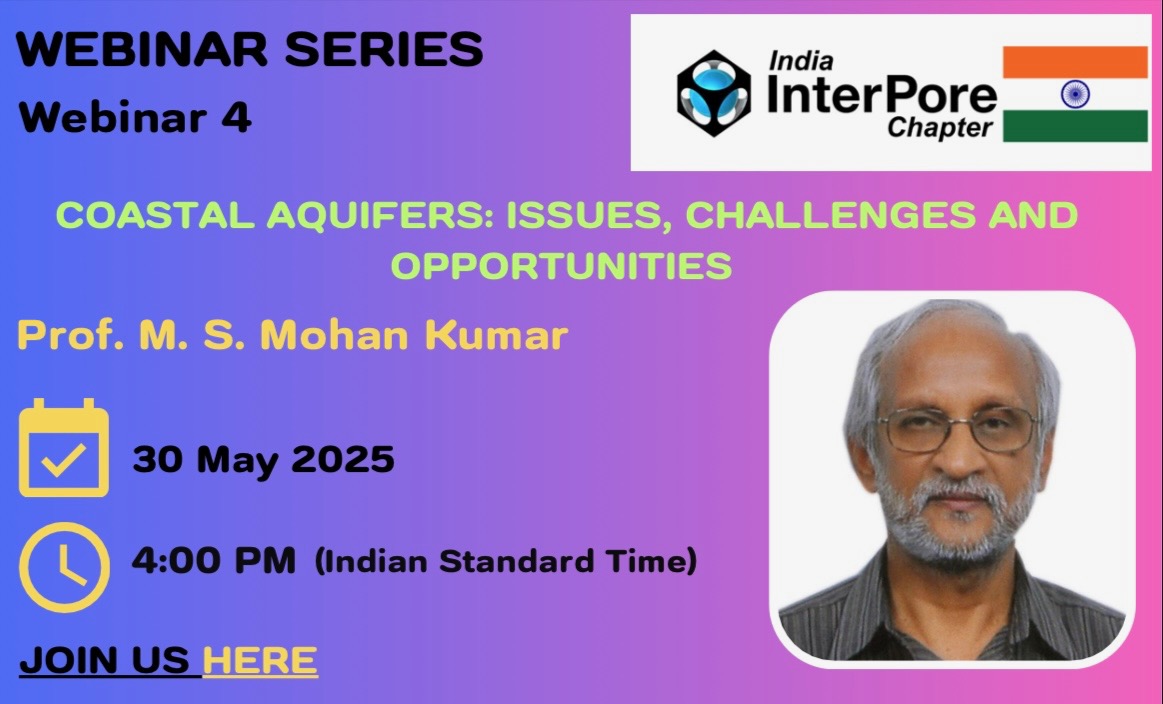Webinar Series: Coastal Aquifers: Issues, Challenges, and Opportunities
Meeting Link: https://meet.google.com/vtv-xjbb-cki
Event Flyer can be downloaded here
India has a vast coastline of around 11,000 Km including its union territories and islands. The coast can be classified into East and West coasts, each with very distinct geological characteristics with very varied types of rainfall.. Many cities across the country are in the coastal region because of their best conditions for productivity from deltaic plains, harbors, industries, etc. Also, these regions have great recreational value. The ongoing rapid urbanization, population growth, climate change, and enormous economic development have exacerbated the freshwater demand in these regions. The main hydrological problems are flooding due to cyclones, wave surges, and seawater intrusion and pollution. The coastal region faces major freshwater scarcity because of salinity intrusion into the aquifers and estuaries. Seawater intrusion into the coastal aquifer is a special category of contamination. The primary drivers for the seawater intrusion are climate change( sea level rise), anthropogenic activities (such as excessive pumping, change in land use/land cover, etc.); hydrological parameters (such as recharge rate, evapotranspiration, etc.); and hydrogeological parameters (such as hydraulic permeability parameters, solute transport parameters, etc.). Numerical models are widely used to understand the interaction between freshwater and seawater intrusion, enabling better management of coastal aquifers. However, there are several constraints in modeling such as field measurements, computational resources, real-time data, over-simplification of conceptual models, etc. Here, we illustrate an example to address some of these important issues. The critical insight into aquifer anisotropy, heterogeneity, and layering for effective simulation of groundwater flow and seawater intrusion by using three methods namely, analyzing the field data, inverse modeling, (deterministic), and intrinsic upscaling(stochastic) are discussed. Coastal aquifer modeling also gives vital information about the submarine groundwater discharge. The potential use of submarine groundwater discharge as a water resource and offshore groundwater resources are discussed. The coastal regions are the critical terminals of the discharge from municipalities, industries, agricultural land runoff, and other contaminants. It is important to understand. the details of contamination and model it as a multiphase flow or immiscible flow depending on the need and field situations. A brief discussion is made on the current status of work on the coastal aquifer encompassing field measurement approaches, sand tank model experiments, conceptual models developed, upscaling of geological/hydraulic parameters, geological controls leading to coastal surface/subsurface reservoirs, contaminant accumulation, and mitigation. Further futuristic research areas such as 2D/3D modeling, parameter identification and estimation with proper forcing of field measurements, and understanding of the behavior of coastal aquifers through physical/chemical/biological measurement signatures are discussed.
About the Speaker: Prof M S Mohan Kumar holds PhD and Master’s degree in water Resources Engineering from Indian Institute of Science, Bangalore and served in IISc for 35 years as Faculty member is working in the broad area of flow and contaminant transport in both natural and man made systems. He has been involved in several international as well as national projects in both research and consultancy mode. He has guided many PhDs and Masters students and published many papers in international and national journals. He has been recipient of several prestigious fellowships and member of several professional bodies. He was a Visiting Professor to Saga University, Japan and to Utrecht University, The Netherlands. Formerly, he was a Professor of Water Resources & Environmental Engineering, Indian Institute of Science, Bangalore. Currently, he is a member of several technical committees of Government on drinking water and irrigation systems both at State & Central Govt level and Member of Editorial committee of CPHEEO on Manual Preparation on Drinking water supply, Member National Task Force on 24x7 water supply of GOI. He is a member/Chairman of several committees set up by Department of Science and Technology, GOI on Water research. He was the Pro-Vice Chancellor, GITAM University, Bangalore. Currently he is an Adjunct Professor at the Department of Civil Engineering,Indian Institute of Technology Madras, Chennai.



